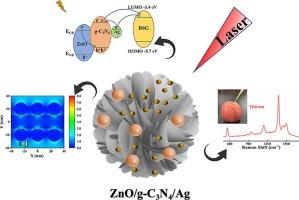三维ZnO/g-C3N4/Ag SERS底物:水果痕量农药检测的三合一协同增强策略
IF 6.9
2区 材料科学
Q2 CHEMISTRY, PHYSICAL
引用次数: 0
摘要
表面增强拉曼散射(SERS)衬底具有强烈的热点、优越的电荷转移和特殊的吸附性能,在水果上的超灵敏农药检测中引起了人们的极大兴趣。在此,我们开发了以超薄g-C3N4涂层和Ag纳米粒子(ZnO/g-C3N4/Ag)装饰的三维ZnO纳米花作为SERS衬底。电磁模拟结果表明,ZnO/g-C3N4纳米片增强了电磁场局部化,并产生了丰富的“热点”。ZnO/g-C3N4纳米片还提供了广泛的异质结区域,改善了分析物的吸附,促进了电荷的分离和转移。这些协同效应产生了卓越的SERS性能,实现了R6G的皮摩尔级检测极限和卓越的自清洁能力。该底物可有效检测苹果皮上的多种农药,检出限低至几ng/cm2。本研究为开发新型3D g- c3n4基SERS底物铺平了道路,推进了水果农药残留的高灵敏度检测。本文章由计算机程序翻译,如有差异,请以英文原文为准。

Three-dimensional ZnO/g-C3N4/Ag SERS substrate: A three-in-one synergistic enhancement strategy for trace-level pesticide detection on fruits
Surface-enhanced Raman scattering (SERS) substrates with intense hot spots, superior charge transfer, and exceptional adsorption properties have garnered significant interest in ultrasensitive pesticide detection on fruits. Herein, we developed three-dimensional ZnO nanoflowers coated with ultrathin g-C3N4 layers and decorated with Ag nanoparticles (ZnO/g-C3N4/Ag) as SERS substrates. Electromagnetic simulations reveal that the ZnO/g-C3N4 nanosheets enhance electromagnetic field localization and generate abundant “hot spots”. The ZnO/g-C3N4 nanosheets also provide extensive heterojunction areas and improve analyte adsorption, facilitating charge separation and transfer. These synergistic effects yield exceptional SERS performance, achieving a picomolar-level detection limit for R6G and exceptional self-cleaning capabilities. This substrate effectively detects multiple pesticides on apple skin, with detection limits as low as a few ng/cm2. This research paves the way for developing novel 3D g-C3N4-based SERS substrates, advancing the highly sensitive detection of pesticide residues on fruits.
求助全文
通过发布文献求助,成功后即可免费获取论文全文。
去求助
来源期刊

Applied Surface Science
工程技术-材料科学:膜
CiteScore
12.50
自引率
7.50%
发文量
3393
审稿时长
67 days
期刊介绍:
Applied Surface Science covers topics contributing to a better understanding of surfaces, interfaces, nanostructures and their applications. The journal is concerned with scientific research on the atomic and molecular level of material properties determined with specific surface analytical techniques and/or computational methods, as well as the processing of such structures.
 求助内容:
求助内容: 应助结果提醒方式:
应助结果提醒方式:


